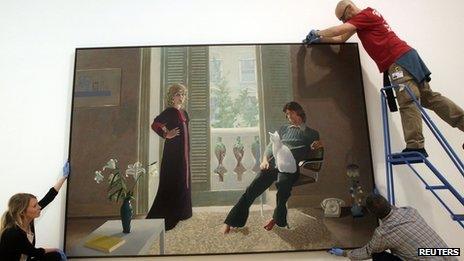Tate Britain rehang 'triumphant'
- Published

David Hockney's Mr and Mrs Clark and Percy is among works featured in A Walk Through British Art
Tate Britain's reorganisation of 500 British artworks in chronological order has been praised by newspapers, with the Independent hailing a "triumphant new hang".
The gallery said A Walk Through British Art, featuring work from the 1500s to the present day, allowed "a more neutral view of the range of art being produced at any one historical moment to emerge".
It also features new permanent galleries devoted to poet and artist William Blake and sculptor Henry Moore.
Michael Glover - The Independent
The curators have been encouraged to look at the Tate's vast holdings year by year, with a plodding degree of thoroughness, in order to spot the unusual. Those many unusuals have now been deftly inserted into the story of British art. New names interrupt the flow.
What is more, paintings made at about the same time - they might be separated by just a year or two - have, generally speaking, been hung close to each other so that we can see for ourselves quite how much obfuscation has gone on in the past, how many lies or half-truths the tellers of art's tale have been peddling.
Richard Dorment - Daily Telegraph
The first thing to say about [Tate Britain director Penelope] Curtis's rehang is that it is gloriously, satisfyingly, reactionary.
In 20 galleries that are intended as an introduction to British art for the general public, about 500 works of art including paintings, sculpture and drawings are hung chronologically from the 16th to the 21st centuries. This is art history as it used to be taught before it was hijacked by academic theorists.
Every gallery is labelled by the date of the art shown in it, and just in case anyone might think the redisplay is temporary, those dates are set into the floor in large gold letters at the entrance.
Rachel Campbell-Johnston - The Times
There are several winners in this chronological hand. The principal one is Tate Britain: where the collection is thin, the ground can be covered more evenly...
The loser looks set to be the student armed with his or her art history book. The labelling is minimal. There is nothing to guide you through major art movements. And so what, to the expert, might seem delightfully risque, may feel confusing to the novice.
The curators' answer is simple - use your eyes.
Jonathan Jones - The Guardian
Visitors to Tate Britain are in for a shock. It may take a while to register. When it does, the revolution perpetrated by the museum's director, Penelope Curtis, explodes into view.
There are no explanatory texts by the works of art...
What truly stands out, from the sensitive choices of real gems of artworks to their spacious yet detailed placing in sumptuously redecorated galleries, is the passion for British art that fuels this epic display.
It makes the case for British art, not just today but since the 1500s, as abounding in originality, ripe with personality, and often unexpectedly beautiful. It is a revelatory journey to meet the British.
Louise Jury - Evening Standard
John William Waterhouse's The Lady of Shalott and Constable's Flatford Mill share the limelight with more recent acquisitions such as the Chapman brothers' spoof ethnographic carvings and a painting by this year's Turner Prize-nominated Londoner Lynette Yiadom-Boakye entitled 10pm Saturday.
There is more sculpture than before. Moore, twice a Tate trustee, has been honoured for his strong connections with the gallery while the dedicated Blake gallery recognises the Tate's long association with the visionary artist.
Dr Curtis encouraged curators to really trawl the collection for surprises and labels are placed at the foot of the works to remove visual clutter.
- Published19 April 2013